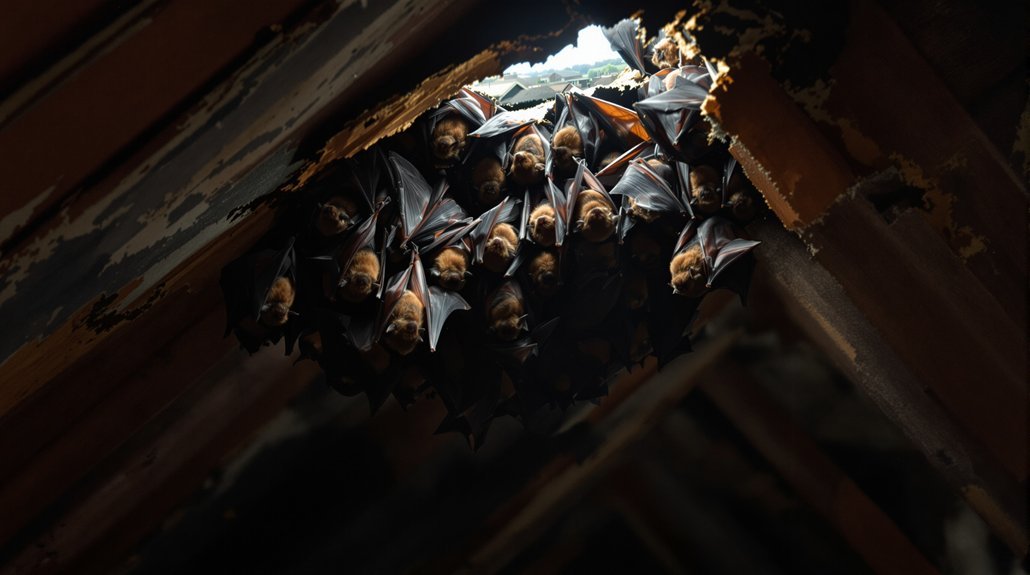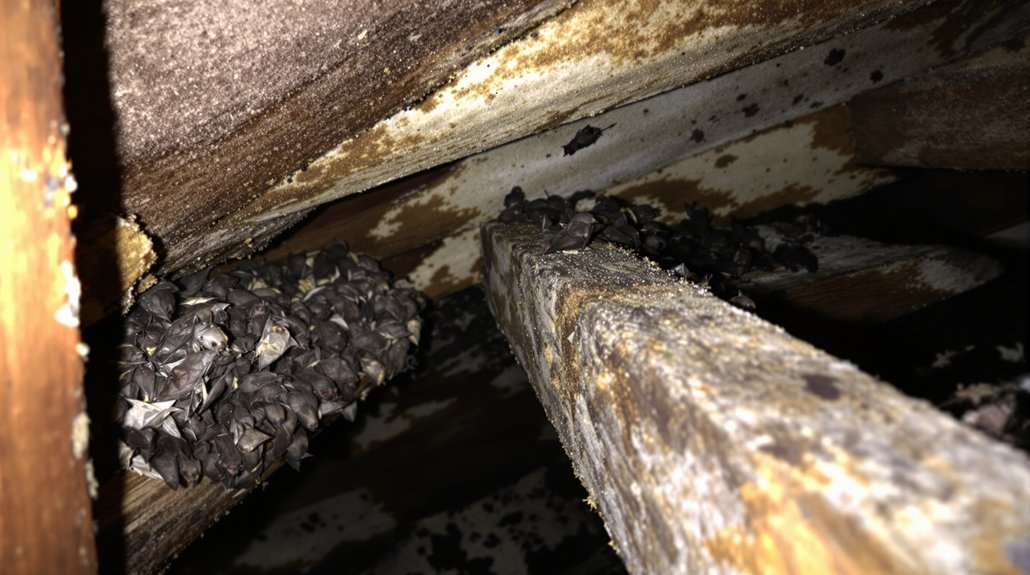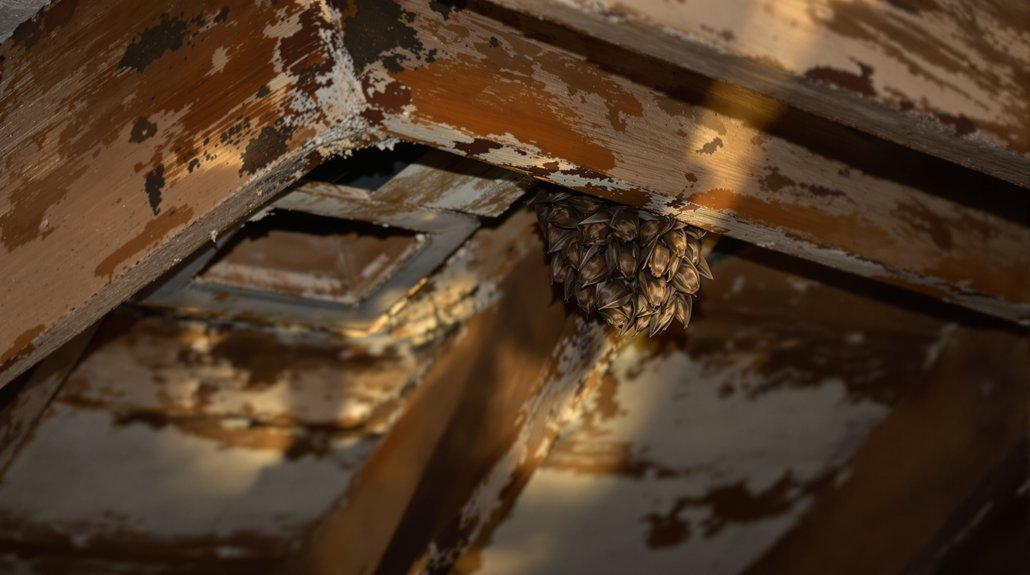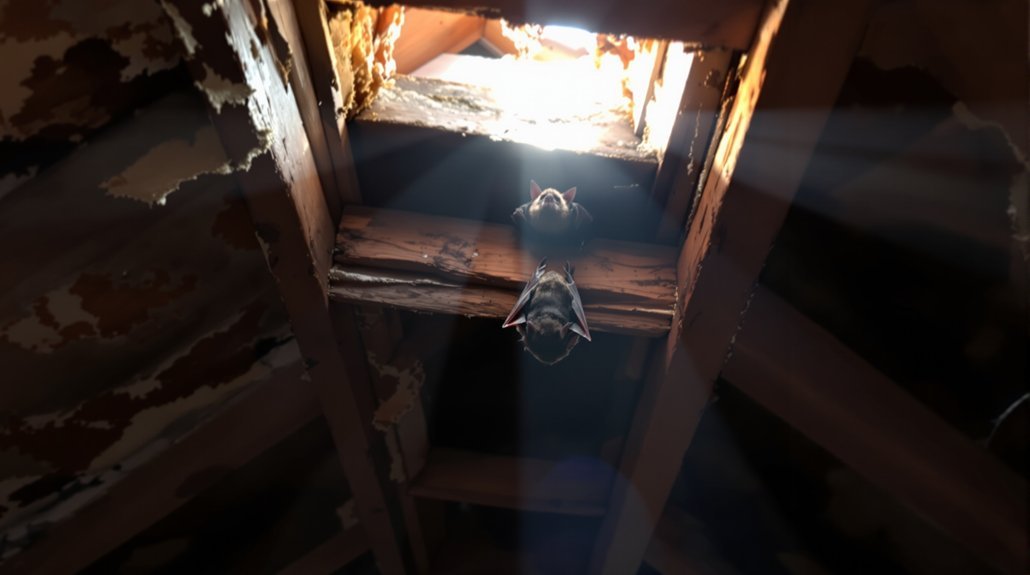Worrying about bats in an attic in Des Moines is justified. Bats can create health risks and property damage. They may carry diseases like rabies and their droppings can lead to lung infections. Over time, they can damage insulation and structures, causing costly repairs. However, bats also serve important roles in the ecosystem, helping with pest control and pollination. Understanding how to manage a bat situation properly is important for both safety and coexistence. More details are available to help navigate this issue.
Key Article Highlights
- Bats in your attic can indicate a healthy ecosystem but may pose health risks, including rabies and histoplasmosis from guano.
- Signs of bat infestation include droppings, scratches on walls, and noises, which require early detection to prevent larger problems.
- Accumulated guano can damage insulation and attract pests, leading to costly repairs and property integrity issues.
- Bats are protected by local laws; unauthorized removal can result in legal consequences, making it essential to consult professionals.
- Prevent future infestations by sealing entry points, conducting regular inspections, and engaging wildlife experts for safe removal and compliance with regulations.
Understanding the Importance of Bats in the Ecosystem

Although many people view bats with fear or misunderstanding, they play a vital role in maintaining the health of ecosystems. Bats provide essential ecosystem services, such as controlling insect populations. They consume vast amounts of insects, including pests that can harm crops. This natural pest control helps farmers and reduces the need for chemical pesticides, promoting a healthier environment. Bat conservation is important to guarantee these animals continue to thrive. Protecting bat populations helps maintain the balance of ecosystems. Healthy bat colonies contribute to biodiversity, which is crucial for resilient ecosystems. By understanding the importance of bats, communities can appreciate their value and support efforts for their conservation. Recognizing these benefits can lead to a more harmonious coexistence with these misunderstood creatures. Damage management strategies ensure that human-bat interactions are safe and beneficial for both parties. Supporting bat populations through habitat preservation is also vital for their continued ecological contributions.
Identifying the Signs of a Bat Infestation

How can homeowners tell if they have a bat infestation? Identifying the signs is vital for timely action. Homeowners should look for the following indicators:
- Bat droppings: These small, dark pellets can be found near entry points or around the attic.
- Wing scratches: Marks on walls or ceilings may indicate bats are roosting in the area.
- Noises: Sounds of fluttering or squeaking at dusk or dawn can signal bat activity.
Recognizing these signs early can help prevent a larger infestation. Homeowners should monitor their attics and surrounding areas regularly. If these signs are present, it may be time to seek professional help to safely remove the bats and address any entry points in the home.
Potential Health Risks Associated With Bats

Bats can pose several health risks to homeowners if they invade an attic. One major concern is the transmission of diseases, such as rabies, which can be deadly. Bat droppings, known as guano, can also carry histoplasmosis, a serious lung infection. These health issues highlight the difference between bat mythology, which often portrays bats as harmless creatures of the night, and bat facts that reveal their potential dangers. Additionally, bats may attract other pests, further complicating the health risks. Understanding these threats is essential for homeowners, as ignoring them can lead to severe consequences. It is advisable to take proper precautions and seek professional help if bats are discovered in an attic. Awareness is key to ensuring safety.
Property Damage Caused by Bats
The presence of bats in an attic can lead to significant property damage. Homeowners should be aware of the potential issues caused by these creatures.
- Bat droppings can accumulate and cause staining on surfaces.
- Attic insulation may become contaminated, leading to costly replacements.
- Structural damage can occur, as bats may create holes in roofs and walls.
In addition to the health risks, bat droppings, also known as guano, can produce strong odors and attract pests. The insulation can lose its effectiveness when soiled, resulting in increased energy costs. Repairing the damage caused by bats can be expensive and time-consuming. Consequently, it is essential to address any bat presence in the attic promptly to prevent further property damage.
Benefits of Having Bats Nearby
Bats provide several benefits when they are nearby. They help control pests by eating insects, which can reduce the need for chemical pesticides. Additionally, bats play a role in maintaining ecosystem balance and can assist with pollination for some plants.
Natural Pest Control
Having bats nearby can be beneficial for natural pest control, especially in urban areas like Des Moines. These silent flyers play a vital role in managing insect populations. Bats can help keep homes and gardens free from pests, contributing to a healthier environment.
- They consume large quantities of insects, such as mosquitoes and moths.
- Bats help reduce the need for chemical pesticides.
- Their presence supports a balanced bat habitat, fostering biodiversity.
Ecosystem Balance
Why are bats important for maintaining ecosystem balance? Bats play a crucial role in controlling insect populations, which helps keep gardens and crops healthy. They consume large quantities of insects, reducing the need for chemical pesticides. This natural pest control contributes to a balanced ecosystem. Many urban myths and bat myths paint bats as dangerous creatures, leading to fear and misunderstanding. In reality, bats are beneficial to humans and the environment. By maintaining insect populations, they support the food chain and promote biodiversity. The presence of bats nearby can indicate a healthy ecosystem. Therefore, rather than fearing bats, communities should recognize their value and work to coexist with these important animals.
Pollination Assistance
The role of bats extends beyond insect control; they also contribute considerably to pollination. Many plants depend on bats for reproduction, making them crucial to ecosystems. Their nocturnal activity aids in the pollination of various flowers, especially those that bloom at night.
Key benefits of having bats nearby include:
- Improved Crop Yields: Bats help pollinate fruit and nut trees, enhancing food production.
- Biodiversity Support: Bat-assisted pollination promotes a diverse range of plant species.
- Natural Pest Control: While aiding pollination, bats also manage insect populations, benefiting gardens and farms.
Bat acoustics help them navigate and locate flowers, making their role in pollination efficient and essential for maintaining healthy habitats.
Safe Removal and Exclusion Techniques
When homeowners discover bats in their attic, it is essential to employ safe removal and exclusion techniques. One effective method is bat mistnetting, which captures bats without harming them. This technique allows for their safe relocation. After removal, it is important to conduct guano cleanup. Bat droppings can pose health risks, so proper cleaning is necessary. Homeowners should wear protective gear during this process to avoid exposure to harmful pathogens. Once the area is clean, sealing entry points is critical to prevent future infestations. Using materials like caulk or metal mesh can effectively block these openings. Implementing these techniques ensures a safe and humane approach to managing bats in the attic.
Legal Considerations for Bat Removal in Des Moines
Legal considerations for bat removal in Des Moines are important for homeowners. Local wildlife regulations may require permits for any removal activities. Following safe removal practices is essential to protect both the bats and the residents.
Local Wildlife Regulations
Bats in Des Moines are protected by local wildlife regulations, which can complicate removal efforts. Understanding these regulations is vital for homeowners facing bat issues in their attics. Key points to contemplate include:
- Bat migration patterns, which can affect when removal is permitted.
- Roost management practices that help maintain bat populations while ensuring safety.
- Potential legal consequences for improper removal actions.
Homeowners must navigate these laws carefully to avoid fines or other penalties. It’s important to consult with wildlife professionals who understand the regulations surrounding bat removal. They can provide guidance on safe and legal methods to manage bats, ensuring compliance with local wildlife protections while addressing bat-related concerns effectively.
Permits for Removal
Homeowners in Des Moines facing bat removal must consider the need for permits. Local laws often protect bat species, making it indispensable to understand the legal requirements before proceeding. Removing bats without proper authorization can lead to fines or legal issues. Additionally, homeowners should be aware that bat guano can pose health risks and must be handled carefully. Before removal, it is advisable to conduct colony counting to assess the size of the bat population. This information can aid in obtaining the necessary permits and ensuring compliance with local regulations. Consulting wildlife experts or local authorities is recommended to navigate the permit process effectively and safely. Understanding these legal considerations is essential for responsible bat removal.
Safe Removal Practices
When considering bat removal, it is essential to follow safe practices to protect both the animals and the environment. Bats play an important role in the ecosystem, and improper removal can harm them. In Des Moines, it is crucial to be aware of bat migration and roost selection when planning removal.
- Use humane methods to encourage bats to leave naturally.
- Evaluate the timing of removal to avoid disrupting migration patterns.
- Consult local wildlife authorities for guidance and support.
Preventative Measures to Avoid Future Infestations
To prevent future infestations of bats in attics, it is essential to take proactive measures. Homeowners should employ effective bat proofing techniques to safeguard their properties. This includes sealing any cracks or gaps in walls, roofs, and around vents. Installing screens on chimneys and vents can also aid in exclusion methods. Additionally, keeping attics well-lit and ventilated may deter bats from roosting. Regular inspections should be conducted to identify potential entry points and ensure they remain closed. Landscaping should be managed to reduce hiding spots near the home. By following these simple steps, homeowners can considerably decrease the likelihood of bats returning to their attics, ensuring a safer and more comfortable living environment.

